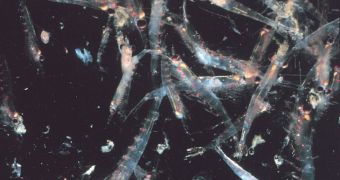A shrimp-like animal that makes up the basis of the food chain spreading across Antarctica has been found to be the most important player in bringing iron to the Southern Ocean. The creature, called krill, contributes to the growth and blooming of phytoplankton.
These are microscopic organisms that make up the first link in the food chain in all oceans. Without it, there would be nothing feeding the fish, which in turn would die off and leave the predators without a food source.
Phytoplankton is known to bloom in the presence of the element iron, which krills apparently provide in abundance. The most important aspect of this interplay is the fact that more blooms allow for the ocean to store even more carbon dioxide.
This is becoming increasingly important today, as our species is eliminating increasingly large amounts of the dangerous greenhouse gas into the atmosphere. The oceans are trying to absorb all the carbon dioxide, but there is only so much they can store.
Phytoplankton consumes CO2, and then carries small amounts of the element down to the ocean floor, where it is deposited in a sediment layer. Naturally, the more such organisms there are, the more carbon is stored, and therefore eliminated from the atmosphere.
This process is facilitated to a great extent in the Southern ocean around Antarctica by krill, researchers write in a paper published in this month's issue of the scientific journal Limnology and Oceanography.
Antarctic krill (Euphausia superba) apparently feed on the iron-rich fragments of decaying organisms on the seafloor much more often than researchers thought. As they reach the surface of the water, they release that iron into the upper layers of the ocean.
This allows phytoplankton more access to the chemical, which in turn triggers more blooms. Some of these can grow to such impressive sizes that they can even be seen from Earth's orbit, EurekAlert reports.
“We are really excited to make this discovery because the textbooks state krill live mainly in surface waters. We knew they make occasional visits to the sea floor but these were always thought as exceptional,” says Dr. Katrin Schmidt.
“What surprises us is how common these visits are – up to 20% of the population can be migrating up and down the water column at any one time,” adds the expert, the lead author of the work, and an expert at the British Antarctic Survey (BAS).
“The next steps are to look at exactly how this iron is released into the water,” Schmidt concludes.

 14 DAY TRIAL //
14 DAY TRIAL //